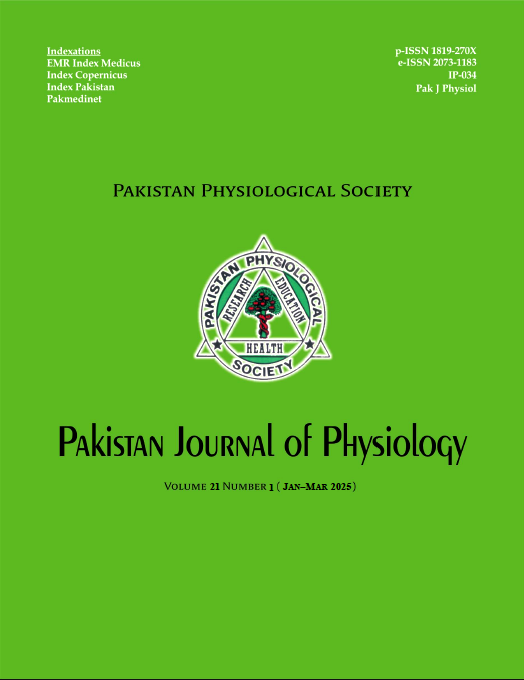COMPARISON OF IRON ALONE VERSUS IRON COMBINED WITH VITAMIN A FOR MANAGING IRON DEFICIENCY ANAEMIA
DOI:
https://doi.org/10.69656/pjp.v21i1.1752Keywords:
iron, iron deficiency anemia, vitamin AAbstract
Background: Iron deficiency is the most prevalent nutritional deficiency and a significant global public health concern. This study aims to rapidly reduce the prevalence of iron deficiency anaemia (IDA) and prevent related cognitive impairments in children. Objective was to compare the effectiveness of iron alone versus iron combined with Vitamin-A in reducing iron deficiency anaemia in children (aged 6–59 months of age). Methods: This randomized controlled trial over 6 months conducted in Department of Paediatrics, PAC Hospital, Kamra. Study included 104 children (52 in each group), aged 6–59 months, of either gender, with haemoglobin levels below 11 g/dL and serum ferritin levels below 12 ng/mL. Participants were randomly assigned to two groups: Group A received iron plus Vitamin A, while Group B received only iron therapy. After three months, patients were assessed for changes in haemoglobin concentration and ferritin levels as ferritin stores replenish in specified period. Data were recorded using a specially designed form. Results: In Group A, the mean age was 37±7.10 months, and in Group B, it was 40±6.25 months. In Group A, 27 (52%) children experienced a reduction in IDA, and in Group B, 15 (29%) children showed a reduction in IDA. Older children in Group A and those having literate mothers showed better improvement in IDA in Group A. Conclusion: Combining iron with Vitamin A is more effective than iron alone in reducing iron deficiency anaemia in children.
Pak J Physiol 2025;21(1):41–4, DOI: https://doi.org/10.69656/pjp.v21i1.1752
Downloads
References
Silva-Neto LGR, Dos Santos Neto JE, de Menezes Toledo Florêncio TM. Association between vitamin A supplementation and stunting and anaemia in socially vulnerable Brazilian children. Eur J Nutr 2024;63(8):3281–8.
Silva AP, Pereira ADS, Simões BFT, Omena J, Cople-Rodrigues CDS, de Castro IRR, et al. Association of vitamin A with anaemia and serum hepcidin levels in children aged 6 to 59 mo. Nutrition 2021;91-92:111463.
Nihal O. Iron deficiency anaemia: From diagnosis to treatment in children. Turk Arch Pediatr 2015;50:11–9.
Moscheo C, Licciardello M, Samperi P, La Spina M, Di Cataldo A, Russo G. New Insights into Iron Deficiency Anaemia in Children: A Practical Review. Metabolites 2022;12(4):289.
Michelazzo FB, Oliveira JM, Stefanello J, Luzia LA, Rondo PH. The influence of vitamin A supplementation on iron status. Nutrients 2013;5(11):4399–413.
Conway M, Macron P, Meinert P, Durno C, Upton MEJ, Kirby-Allen M, et al. A toddler with treatment-resistant iron deficiency anemia. Pediatrics 2018;142(1):e20172971.
Parkin PC, DeGroot J, Maguire JL, Birken CS, Zlotkin S. Severe iron deficiency anaemia and feeding practices in young children. Public Health Nutr 2015;19(4):716–22.
Habib MA, Black K, Scoofi SB, Hussain I, Bhatti Z, Bhutta ZA, et al. Prevalence and predictors of iron deficiency anemia in children under five years of age in Pakistan, A secondary analysis of National Nutrition Survey data 2011–2012. PloS One 2016;11(5):e0155051.
Mantadakis E. Advances in pediatric intravenous iron therapy. Pediatr Blood Cancer 2016;63(1):11–16.
Siddiqui SS, Jaybhaye DL, Kale A, Kakade J, Engade M, Haseeb M. Efficacy and Safety of intravenous iron sucrose therapy in a Group of Children with Iron Deficiency Anaemia. Int J Contemp Pediatr 2015;2:12–6.
Arnab B. Role of vitamin A supplementation in the management of iron deficiency anaemia in children. Int J Community Med Public Health 2018;5(4):1477–80.
Al-Mekhlafi HM, Al-Zabedi EM, Al-Maktari MT, Atroosh WM, Al-Delaimy AK, Moktar N, et al. Effects of vitamin A supplementation on iron status indices and iron deficiency anaemia: A randomized controlled trial. Nutrients 2014;6:190–206.
Lannotti LL, Tielsch JM, Black MM, Black RE. Iron supplementation in early childhood: Health benefits and risks. Am J Clin Nutr 2006;84(6):1261–76.
Ghazi SS, Shah M, Riaz N, Hashim F, Krishan J, Khan A. Single iron suplemantation versus combined vitamin A and iron supplementation in treatment of Iron deficiency anemia in children less than 5 years visiting tertiary care hospital of Islamabad: A randomized control trial. Isra Med J 2020;12(2):56–9.
Qadir W, Khan S, Bilal A, Shahzad MS, Rafique A, Fakhar us Zaman M. Comparison of iron supplemenatation versus combination of vitamin a & iron supplemenatation in childhood iron deficiency anaemia. J Alama Iqbal Med Coll 2023;21:251–5.
Zimmermann MB, Biebinger R, Rohner F, Dib A, Zedar C, Hurrell RF, et al. Vitamin A supplementation in children with poor vitamin A and iron status increases erythropoietin and haemoglobin concentrations without changing total body iron. Am J Clin Nutr 2006;84(3):580–6.
Da Cunha MSB, Campos Hankins NA, Arruda SF. Effect of vitamin A supplementation on iron status in humans: A systematic review and meta-analysis. Crit Rev Food Sci Nutr 2019;59(11):1767–81.
Kumar SB, Arnipalli SR, Mehta P, Carrau S, Ziouzenkova O. Iron deficiency anemia: Efficacy and limitations of Nutritional and Comprehensive Mitigation Strategies. Nutrients 2022;14(14):2976.
Cappellini MD, Motta I. Anemia in clinical practice-definition and classification: does hemoglobin change with aging? Semin Hematol 2015;52(4):261–9.
Downloads
Published
How to Cite
Issue
Section
License
Copyright (c) 2025 Sadia Mir, Attia Bano, Hina Batool Siddiqui, Nasreen Ali, Noor-e-Sahar, Madiha Noor

This work is licensed under a Creative Commons Attribution-NoDerivatives 4.0 International License.
The author(s) retain the copyrights and allow their publication in Pakistan Journal of Physiology, Pak J Physiol, PJP to be FREE for research and academic purposes. It can be downloaded and stored, printed, presented, projected, cited and quoted with full reference of, and acknowledgement to the author(s) and the PJP. The contents are published with an international CC-BY-ND-4.0 License.












